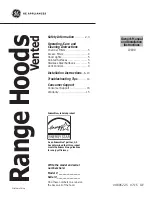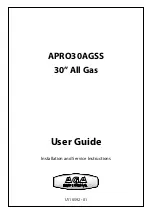
35
Problem
Possible Causes
Solutions
Oven smokes
excessively when
broiling.
Oven door was closed.
Be sure oven door is open when broiling.
Meat too close to upper
element.
Reposition oven rack lower to provide proper clearance between
the food & the upper element.
Excessive spillovers or
grease built up inside oven.
Regular cleaning is needed when broiling frequently.
Meat not prepared for broil.
Remove excess fat from meat. Remove fatty edges.
Insert placed incorrectly on
broil pan (some models).
Always place insert on the broil pan with ribs up and slot holes
downward. This will allow grease to drip into pan (some models).
Flames inside oven
or smoking from
oven vent.
Excessive food spillovers in
oven.
Wipe up any excessive spillovers before starting the oven. Should
an oven fire occur, close the oven door and turn the oven OFF. If
the fire continues, use a fire extinguisher. DO NOT put water or
flour on the fire! Flour may be explosive.
Surface element
does not heat.
Cookware materials and weight of the material affect heating.
Heavy & medium-weight pans heat evenly. Because lightweight
pans heat unevenly, foods may burn easily.
Surface element too
hot or not hot
enough.
Be sure the correct control is ON for the element that you are
attempting to use.
Incorrect control setting.
Incorrect control setting.
Adjust the surface power level setting lower or higher to match
the cookware size and quantity of food.
Cookware material or
weight.
Element heating area
extends beyond
cookware bottom.
Cookware too small for
cooktop element used.
If available, move cookware to smaller surface element or place
food in larger cookware.
Surface element
slow to heat food.
Incorrect control setting.
Move cookware to larger element on cooktop if available or if
possible place food in smaller cookware.
Cookware much larger than
element pattern on cooktop.
Adjust the power level to a higher setting.
Condition of cookware.
Use only flat, evenly balanced, medium or heavyweight cookware.
Flat pans heat better than warped pans.
Solutions to common problems
•
BEFORE YOU CALL
Scratches or
abrasions on
cooktop surface.
Coarse particles such as salt
or sand between cookware
and cooktop surface.
Be sure cooktop surface and bottom of cooking utensils are clean
before usage. Small scratches do not affect cooking and will
become less visible with time.
Use clean, smooth, flat-bottomed cookware.
Cleaning materials not
recommended for ceramic
cooktop have been used.
See "Cooktop Cleaning" and "Cooktop Maintenance" in the Care
and Cleaning section of this Use & Care Guide.
Cookware with rough or dirty
bottoms.
Brown streaks or
specks on cooktop
surface.
Boilovers are cooked onto
cooktop surface.
Metal marks on the
cooktop.
Do not slide metal utensils on cooktop. Use a ceramic-glass
cooktop cleaning creme to remove marks. See "Cooktop Cleaning"
and "Cooktop Maintenance" in the Care and Cleaning section.
Remove discoloration using a ceramic-glass cooktop cleaning
creme. Always be sure to use cookware with clean, dry bottoms.
Sliding or scraping of metal
utensils on cooktop surface.
Boilovers are cooked onto surface. Use razor blade scraper to
remove soil. See "Cooktop Cleaning" in the Care & Cleaning
section.
Area of
discoloration on
cooktop surface.
Mineral deposits from water
and food.


































